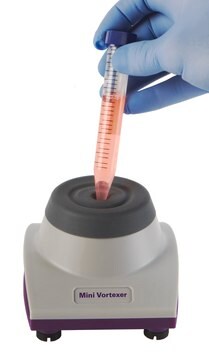Recommended Products
biological source
bacterial (Diplococcus pneumoniae)
Quality Level
form
solution
packaging
pkg of 1,000 U (10742988001 [10 U/μl])
pkg of 200 U (10742970001 [10 U/μl])
manufacturer/tradename
Roche
parameter
37 °C optimum reaction temp.
storage temp.
−20°C
General description
The enzyme is an isoschizomer to Bsp143 I, Dpn II, Mbo I, Nde II and Sau3A I.
Methylation sensitivity
The enzyme is only inhibited by the occurrence of 5-methylcytosine at the indicated site (*) if no 6-methyladenine is present.
Typical ligation and recutting assay
Dpn I fragments obtained by complete digestion of 1μg pBR322 DNA are ligated for 16 hours at +4°C with 1U T4 DNA Ligase in 10μl buffer that contains 66mM Tris-HCl, 5mM MgCl2, 5mM Dithiothreitol, 1mM ATP, pH 7.5 (at +20°C). The percentages of product that can be ligated and subsequently recut with Dpn I (yielding the typical pattern of pBR322 × Dpn I fragments) are stated under "Lig" and "Rec" in the certificate of analysis.
Specificity
GmAT*C
Restriction site: GmA↓T*C
GmA↓T*C
Heat inactivation: No inactivation of Dpn I after incubation at 65 °C for 15 minutes.
Application
Quality
1μg pBR322 DNA is incubated for 16 hours in 50μl SuRE/Cut Buffer A with an excess of Dpn I. The number of enzyme units which do not change the enzyme-specific pattern is stated in the certificate of analysis.
Absence of exonuclease activity
Approximately 5μg [3H] labeled calf thymus DNA are incubated with 3μl Dpn I for 4 hours at +37°C in a total volume of 100μl 50mM Tris-HCl, 10mM MgCl2, 1mM Dithioerythritol, pH approximately 7.5. Under these conditions, no release of radioactivity is detectable, as stated in the certificate of analysis.
Compatibility
DNA Profile
- λ: 116
- φX174: 0
- Ad2: 87
- M13mp7: 8
- pBR322: 22
- pBR328: 27
- pUC18: 15
- SV40: 8
Unit Definition
Analysis Note
The buffer in bold is recommended for optimal activity
- A: 100%
- B: 75-100%
- H: 75-100%
- L: 50-75%
- M: 75-100%
Relative activity in PCR mix (Taq DNA Polymerase buffer) is 100%. The PCR mix contained λDNA, primers, 10 mM Tris-HCl (pH 8.3, 20 °C), 50 mM KCl, 1.5 mM MgCl2, 200 μM dNTPs, 2.5 U Taq DNA polymerase. The mix was subjected to 25 amplification cycles.Activity in reaction buffer of Pwo SuperYield DNA Polymerase PCR Mix is 100%; Pwo SuperYield DNA Polymerase PCR Mix is not available in U.S.
Other Notes
Kit Components Only
- Enzyme Solution
- SuRE/Cut Buffer A 10x concentrated
Storage Class Code
12 - Non Combustible Liquids
WGK
WGK 1
Flash Point(F)
does not flash
Flash Point(C)
does not flash
Certificates of Analysis (COA)
Search for Certificates of Analysis (COA) by entering the products Lot/Batch Number. Lot and Batch Numbers can be found on a product’s label following the words ‘Lot’ or ‘Batch’.
Already Own This Product?
Find documentation for the products that you have recently purchased in the Document Library.
Articles
The term “Restriction enzyme” originated from the studies of Enterobacteria phage λ (lambda phage) in the laboratories of Werner Arber and Matthew Meselson.
Related Content
Restriction endonucleases in prokaryotes function primarily to protect against foreign genetic material, notably bacteriophage DNA.
Restriction endonucleases in prokaryotes function primarily to protect against foreign genetic material, notably bacteriophage DNA.
Restriction endonucleases in prokaryotes function primarily to protect against foreign genetic material, notably bacteriophage DNA.
Restriction endonucleases in prokaryotes function primarily to protect against foreign genetic material, notably bacteriophage DNA.
Our team of scientists has experience in all areas of research including Life Science, Material Science, Chemical Synthesis, Chromatography, Analytical and many others.
Contact Technical Service






